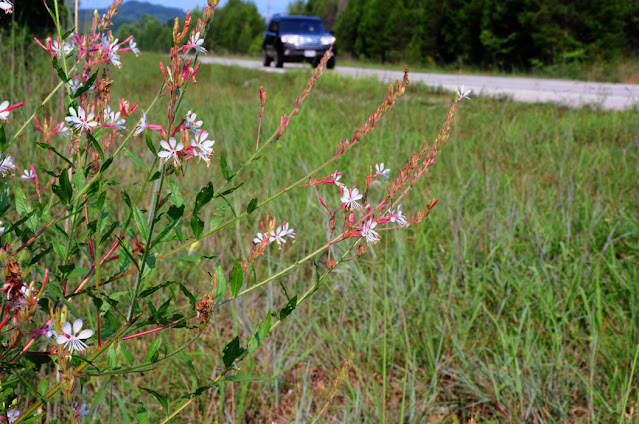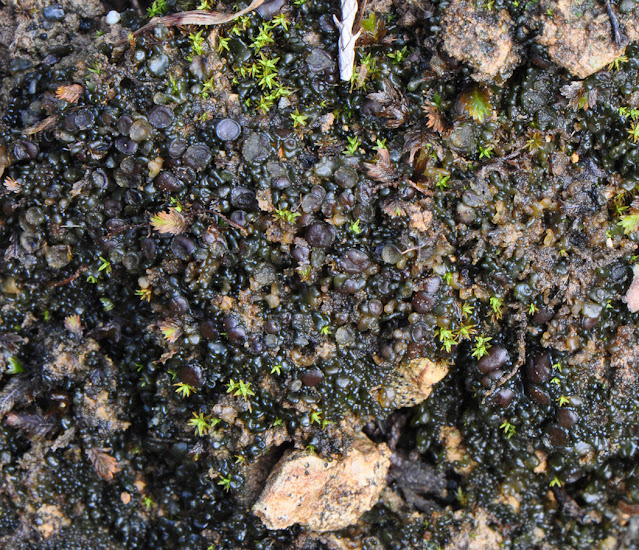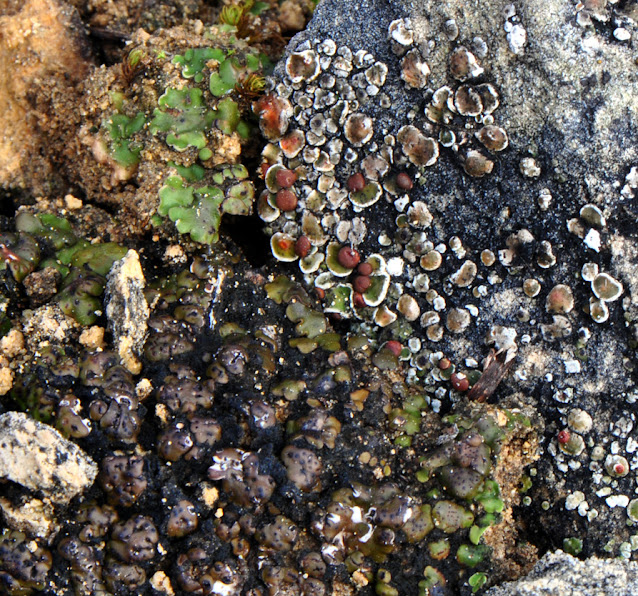What follows are some of the things preserve staff found in preparation for the first report to ODOT.
 |
Canada lily, Lilium canadensis. A native Ohio lily in
the right of way that is pollinated by ruby-throated hummingbirds and larger
bees and moths.
|
 |
Common eastern bumble bee, Bombus impatiens, on spiked
blazingstar, Liatris spicata. |
 |
Angle-pod, Matelea obliqua,is one of the "prairie" milkweeds that tolerate shallow, dry soils and support monarch butterflies both as a nectar source and for their caterpillars. Many native bees also use the plant.
|
 |
Swamp milkweed, Asclepias incarnata, favors the wet ditches of the right of way and are in one of the best families of plants for pollinators; the milkweeds. They also support monarch butterfly caterpillars that feed on the foliage.
|
 |
Whorled milkweed, Asclepias verticillata, is one of the “prairie” milkweeds that tolerant shallow, dry soils and support monarch butterflies both as a nectar source and for their caterpillars. Many native bees also use the plant.
|
 |
Biennial gaura, Gaura biennis, is a true biennial with a pollinator moth named for it, the Gaura moth, Schinia gaura, because its caterpillar eats the plant as well. The caterpillar of the primrose moths, Schinia florida, also feeds on the plant along with other nighttime pollinators that seek its pollen.
|
 |
Purple coneflower, Echinacea purpurea, is one of the very showy, super-pollinator plants that has decreased due to mowing but is still present.
|
 |
An exciting find! The caterpillar of a moth new to science in 2014 was found in the right of way! The coppery orbexilum moth, Grapholita orbexilana, on scurf pea, Orbexilum onobrychis.
|
 |
Butterfly weed, Asclepias tuberosa, is the undisputed pollinator plant champion with bees, butterflies, moths & beetles that use it.
|
 |
Spring ladies-tresses, Spiranthes vernalis, (an orchid). Bumble bee pollinated.
|
 |
Leather flower, Clematis viorna, is bee pollinated.
|
 |
Fringed-leafed ruellia, Ruellia humilis, is pollinated
by generalist bees.
|
 |
Western sunflower, Helianthus occidentalis, previously listed as an endangered species in Ohio, is a pollinator magnet. The native bees Andrena accepta & Andrena aliciae are known to only collect pollen from Helianthus spp.
|
 |
Tall coreopsis, Coreopsis tripteris, is a member of the sunflower family which has one of the richest list of pollinator species.
|
 |
Rose pink, Sabatia angularis, is pollinated by long tongued bees, moths and butterflies.
|
 |
Wood betony, Pedicularis canadensis, is one of the most sought after flowering plants by bumble bees, Bombus spp. Because of the flower’s structure, it is engineered for bumble bees as its main pollinator.
|
 |
Scarlet paintbrush, Castilleja coccinea, blooms in profusion in one particular section of the right-of-way and is spectacular. It is used by many pollinators especially butterflies. It is hemiparasitic, meaning its roots tap into grass roots to get some of its energy so it needs grass around it to survive.
|
 |
Scaly blazing-star, Liatris squarrosa, is potentially threatened in Ohio but common in the right of way. It is used by many pollinators, especially butterflies and native bees.
|
 |
Ear-leaved-foxglove, Agalinis auriculata, is an endangered plant in Ohio and globally is listed as a G3 plant which means it is considered vulnerable throughout the globe. It is one of the more endangered plants found in the right of way.
|
 |
Great Plains ladies’-tresses, Spiranthes magnicamporum, an orchid, is also a potentially threatened plant in Ohio pollinated by bumble bees.
|

|
Crested coralroot, Hexalectris spicata, an orchid, is listed as a potentially threatened plant in Ohio and is found in the right of way. It glues its pollen (pollinia) to insects’ heads in order to cross pollinate.
|
 |
Green star sedge, Carex viridistellata, is growing in a wet ditch just below a first cutback area. This sedge was new to science in 2013 and is considered globally imperiled in the United States (G2) with the major populations being in Ohio. Note the bedrock on the left which is indicative of these shallow soiled prairies along St Rt 125.
|
 |
Tar jelly lichen, Enchylium coccophorum, is a state endangered lichen that grows in rocky soils of the right of way. While lichens are not used by pollinators they are important components of these prairies.
|
 |
Brown stipplescale, Placidium squamulosum, is another state endangered lichen that grows on rocky prairies soils of the right of way.
|
Challenges and Future Work
The three major issues in the project area: 1) repeated mowing so that plants don’t get the chance to flower and set seed. 2) Bringing in soil from other areas that is different from the prairie soils on the sites. 3) The soil from #2 contained seeds from weeds that have proliferated. Issues 2 & 3 are particularly noticeable around guard rail posts where weeds are flourishing and where the native plant community has been buried by the added soil giving non-native plants the upper hand to take over. TNC and CMC staff plan to work on some of these issues with the exception of removing the added soil which is just not possible. Weed control and seeding select native species is possible, as well as removing woody plants that are shading the prairie which are particularly heavy in places.
 |
Non-native plants, especially horseweed, Conyza canadensis, are particularly thick in the soil added around guard rails.
|
 |
Soil brought in from other areas smother native prairie (seen in the foreground). The tall grass in the foreground is big bluestem, Andropogon gerardii, a major species found in tall grass prairies throughout much of the United States.
|
 |
Eastern red cedars, Juniperus virginiana, are growing on a rocky slope above the ditch line. Thinning out these trees would enhance prairie plants by providing the sun they need to flower. In this particular area the trees are somewhat scattered but other areas in the project have solid “walls” of cedar that need to be thinned.
|
Adams County, Ohio is very fortunate to have this native prairie plant community along State Route 125 near Lynx, Ohio. The people passing through this area will enjoy the roadside beauty and a myriad of pollinators and native plants will benefit as well thanks to the efforts of ODOT, District 9.
Special thanks to ODOT District 9 personnel: Blaine Bradds, Kenny Grooms and all the workers at the garage that keep our highways safe and beautiful.
Posted by:Chris Bedel



























